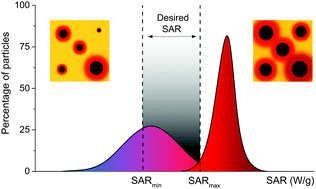Distinguishing between heating power and hyperthermic cell-treatment efficacy in magnetic fluid hyperthermia
Abstract
In the magnetic fluid hyperthermia (MFH) research field, it is usually assumed that achieving a uniform temperature enhancement (ΔT) of the entire tumour is a key-point for treatment. However, various experimental works reported successful cell apoptosis via MFH without a noticeable ΔT of the system. A possible explanation of the success of these negligible-ΔT experiments is that a local ΔT restricted to the particle nanoenvironment (i.e. with no significant effect on the global temperature T) could be enough to trigger cell death. Shedding light on such a possibility requires accurate knowledge of heat dissipation at the local level in relation to the usually investigated global (average) one. Since size polydispersity is inherent to all synthesis techniques and the heat released is proportional to the particle size, heat dissipation spots with different performances – and thus different effects on the cells – will likely exist in every sample. In this work we aim for a double objective: (1) to emphasize the necessity to distinguish between the total dissipated heat and hyperthermia effectiveness, and (2) to suggest a theoretical approach on how to select, for a given size polydispersity, a more adequate average size so that most of the particles dissipate within a desired heating power range. The results are reported in terms of Fe3O4 nanoparticles as a representative example.



 Please wait while we load your content...
Please wait while we load your content...